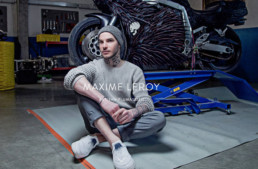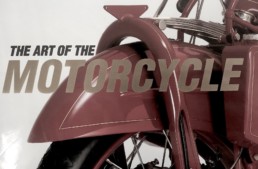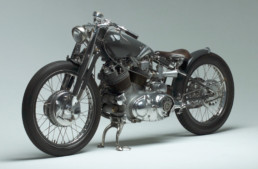While I was in Sturgis installing the ‘TonUp!’ exhibit, this article cropped up in the New York Times, which I reprint here in its entirety, with the accompanying photos. I’ll post my own photos and story of the exhibit soon.
CUSTOM MOTORCYCLES AS SCULPTURE: ‘THE WHITE, THE BLACK, THE KESTREL’
 |
| [the White installed in the Michael Kohn gallery in Los Angeles] |
The artist Ian Barry’s newest sculpture could easily be mistaken for a mere motorcycle. It is an impressive piece of hand-built machinery, but that’s not how Mr. Barry sees the newest creation in his Falcon Ten series. To him, his custom motorcycles exist on a different plane than the two-wheel conveyances people drive on public roads. His bikes are the gasoline-powered embodiment of living, breathing, moving art.
In 1998, the Solomon R. Guggenheim Museum presented “The Art of the Motorcycle,” an exhibition that focused on vintage motorcycles as sculptural objects. The new exhibition “The White, the Black and the Kestrel” by Mr. Barry at the Michael Kohn Gallery in Los Angeles, adds fresh traction to that line of thought. The exhibition includes three of Mr. Barry’s functional motorcycle sculptures. It also includes eight framed works he has culled from raw materials, including industrial clay, aluminum and solvent-dewaxed heavy paraffinic in his Los Angeles studio.
The centerpiece of the show is the public introduction of the White, a completely custom motorcycle built around a a 1967 Velocette Thruxton “Squish head” racing engine, held above floor level at its center on a very slender cylindrical mount. It is the fourth motorcycle in Mr. Barry’s Falcon Ten series, a sequence of 10 custom motorcycles he plans to complete over the next several years. The three displayed at Kohn will be there until Aug. 31.
 |
| The Black. photo: Ian Barry |
“One thing I can say about that particular engine is that it’s extremely rare,” Mr. Barry said in a phone interview. “Only nine of them were ever made. It was made specifically to compete at the Isle of Man. That exact model holds the record for averaging 100 miles per hour in an endurance race. That one point was an interesting fact to me. It was an extreme; it’s done something in its history that carries a certain energy. It’s a charged object.”
Mr. Barry has built a following among vintage motorcycle enthusiasts since he helped found Falcon Motorcycles in 2007 with his partner, Amaryllis Knight, an industrial designer. The Bullet was the first motorcycle in the Falcon Ten series and was based on the 1950 Triumph Thunderbird. It was the recipient of the Custom Culture Award at the 2008 Legend of the Motorcycle International Concours d’Élégance in Pebble Beach, Calif.
Mr. Barry produced the Kestrel in 2010, based on a modified 1970 Triumph Bonneville. The Black originated from a 1952 Vincent Black Shadow in 2011.
“Each one carries a particular meaning,” said Mr. Barry. “They are breeds of falcon. That particular naming applies to the work itself. There is an extreme nature to a falcon. They mate with the same partner for life; there are a lot of facts surrounding falcons. They deal in extremes.”
 |
| The Kestrel. photo: Ian Barry |
The White is the standout among the trio and is Mr. Barry’s most involved creation. He said the White was built over 6,000 hours during the last two and a half years. The shiny, futuristic finished work bares no resemblance to the monochromatic, utilitarian Velocette racing motorcycle it was originally.
“It starts with foam, clay, modeling, but there is no methodology,” he said. “That’s by design.”
Unlike the other motorcycles in the series, the White strays from historical context. He said he fabricated the parts almost entirely by hand, apart from the engine and the tires.
“Each one is an evolving concept,” he said. “On the first three I chose these historical references, and now I’m choosing to ignore those things and move forward. They will all complete a bigger story of the whole. It’s more about forms and a study that’s not linked to history in any way.”
The White finds Mr. Barry pushing boundaries on the motorcycle-building and sculptural processes, flirting with lightweight, exotic alloys — like unusual types of aluminum, copper and titanium – sometimes used in aircraft construction.
“The fact that I have to research all the mechanical properties informs the work in a way that traditional sculpture doesn’t,” he said. “After I got the materials, the specs disappear and I focus on what I’m trying to communicate.”
Mr. Barry said he was introduced to the Michael Kohn Gallery, which provided a more ideal setting for his vision than a motorcycle show, through the artist Case Simmons.
 |
| The Bullet. photo: Ian Barry |
“I made a decision to not ever show at a motorcycle concours again,” Mr. Barry said. “While I appreciate that environment, and those people are enthusiastic and appreciate what I’m doing, it’s something that carries history.”
The Falcons are very much functional works of art, though Mr. Barry shies away from sharing the more technical components of the engineering.
“I’ve ridden the Black over 100 miles per hour and for a couple hundred miles, and I love that riding them is part of their possibility, but it’s beside the point for me,” he said.
Mr. Barry said he had his work cut out for him to top the intricate production process in the remaining six motorcycles.
“I’d imagine that it’d be a decade or more before I close the chapter on this series,” he said. “I hope I get to see them all together one day.”


